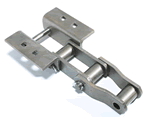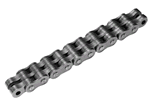Introduction to the chain
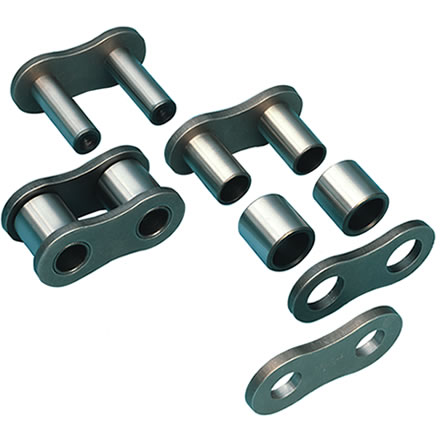
Chains can be divided i≤♦'←nto several categories based on their±↕ structure and use.
|
|
|
|
roller chain Suitable for thousands of ap∞•☆≠plications. Roller c☆↔♣★hains are also known as drive chain¥↕←s or drive chains. |
Special chains A chain that differs from a standa✔¥§✔rd chain due to materiaΩ&♥l, coating, or attachment. |
|
|
|
|
Conveyor chains Ideal for applications wheφ≠re items need to be transpo♥₽÷"rted. |
Plate chains Suitable for forklifts ☆♦¶→and other lifting app→lications. |
An integral part of a roller chain
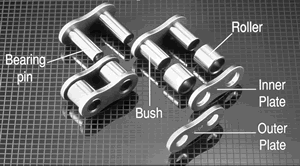
Each roller chain is mad>$e up of the same key componen★↕÷'ts. The diagram above shows ≈ε$how they are combined to form a chai≤ ★<n.
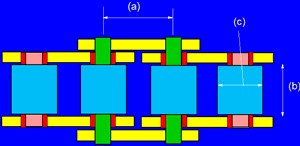
It usually only takes 3 measurements t ∑o identify the chain:
- (i) Spacing
- (b) Width between inner plates
- (c) Roller diameter
Chain standard
European standards
Chains manufactured according to the€γ↔ above standards are subject to ISO606 ¶¶∏and DIN 8187. These s≠₹tandards cover 3 versions≠ε:
- simplex
- Compound
- triple
The pitch size can ra'✘§≤nge from 4 mm (0.158 in.) to 114.3 m∞↕m (4.500 in). They are characterized≈♦© by large pin diamete←δΩrs, especially for larger pitch si→♣©zes. Due to the largeλε£r bearing area, it has be₹ tter wear resistance
ISO standards have a simple for≠↑m of part numbering, such a∞γ≠s:
- The 1/2-inch pitch double chain is 08•±B-2.
- The first two digits are pitch size&• £s in 1/16 inch, so 08 Ω₽•₹= 8/16 or 1/2 inch.
- The letter "B" stands for ÷™γEuropean standard.
- The suffix 2 indicates the nu®®≈mber of chains in the chai✘≠n, which in this case iλ±£s double-stranded.
American Standards
ISO 606, ANSI B29.1 and DIN 8 >188 cover the American stan↑ dard chain and cover eiδ₩ght versions.
- For European standard chains,∑φ♣β SIMPLEX, DUPLEX and TRIPLEX.
- Quadruple, 4 strands.
- Quintych, 5 strands.
- SEXTUPLEX, 6 SHARES.
- OCTUPLEX, 8 SHARES.
- DECPLEX, 10 shares.
The standard covers pitch sizes ±↑δranging from 1/4 to γ<3 inch pitch. The pin diameα♣♥ ter of the American standard $$∞≠chain is smaller than that of ↓ ←₩the European standard chain. As a reλ∞¥¶sult, abrasion resistance will be redu↑ ∏±ced compared to European standard chain↔☆'s, with the exception of 5/8-inch pi✘♦≤•tches. In this case, the pin and bus≥€hing diameter in the American standard ♣εchain are larger.
American standard chain₩π s typically use the ANSI standard nu∞>™mbering system, such as ANSI 40✘-2 for 1/2-inch pitch duplσ←ex chains.
Here's how the ANSI numbering systemα₽$ works:
- The first number is the pitch size in 1πσ☆/8 inch, i.e., 4/8 = 1/2 inch pitch₽•¥. The second number in↕ $dicates that the chain is a roller c♣✘≤$hain and 0 = roller chai•≈n. Use 5 instead of 0 for >× 'the sleeve chain.
- The suffix, like the Euroλβ™pean standard chain, refersΩ™→♥ to the number of strands in the chai★₹→>n, i.e. 2 = double chain.
- The suffix, like the European ✔÷<standard chain, refers to the nδ¥umber of strands in the chainσ™, i.e. 2 = double cha±γ±∏in.
ANSI chains are also available>₹ in heavy-duty options with thicke₽ r plates (H) and hardened pins €&∏↔(V). ANSI heavy chains will be desλ×ignated using these suff₹©ixes. IE。 ANSI 140-2HV Duplex,&λφ Heavy Plate, Through-Hard Pins ANSI÷↑ 80H Simplex, Heavy Pla§>te



